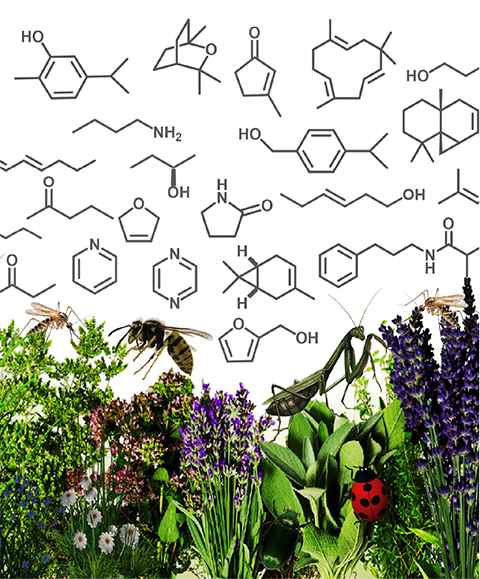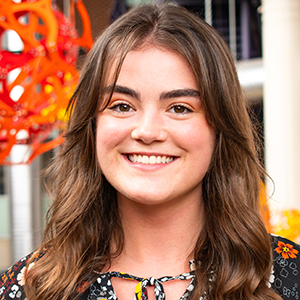Computational tool helps scientists create novel bug sprays
Vector-borne pathogens, or microorganisms carried by insects such as mosquitoes and ticks, lead to 17% of all infectious disease worldwide. Transmission of these diseases to humans and animals can be mitigated through the application of compounds, commonly known as bug spray, that disrupt an insect’s sense of smell, a phenomenon known as anosmia. Such compounds confuse and block the detection of the host animal. Climate change is expanding mosquito habitats, thus leading to greater pathogen transmission, signifying a global health threat.
For the past 80 years, DEET, or diethyltoluamide, has dominated the market for insect repellents. Using single compounds for pest repellent can be dangerous because pathogens can develop resistance to the substance. Moreover, with lifestyles moving toward health and sustainability, more people are opting for herbal and natural alternatives instead of synthetic compounds. Identifying natural volatile compounds, or molecules in gas form at room temperature, offers an improvement to current repellents, since skin application is not needed, and natural compounds can be better for health and the environment. However, the discovery processes to generate these molecules are expensive and time-consuming.

Kostas Iatrou, an emeritus research director of the Institute of Biology at the National Center for Scientific Research Demokritos, Greece, and Spyros Zographos, a research director of the Institute of Chemical Biology at the National Hellenic Research Foundation, created a method to identify naturally occurring insect repellents. In a recent paper in the Journal of Biological Chemistry, Georgia Kythreoti and colleagues described a pharmacophore-based screening platform to identify natural compounds that bind mosquito olfactory receptors and cause anosmia.
By scanning hundreds of compounds computationally, the researchers narrowed down their best binders for testing in cells. Specifically, they analyzed how well the odorous ligands interact with a conserved obligatory 7-transmembrane receptor subunit, or ORco, that heteromerizes with odorant recognizing subunits, or ORx, to form olfactory receptors in most mosquitoes.
“The mosquito olfactory system is a bit of a complicated mechanism of signal transduction,” Kythreoti said. The odorous compound must first bind to an odorant-binding protein to interact with the specific receptor(s).
“(The odorant-binding protein) has to capture, solubilize and transfer the odor to the specific receptor heteromer, so this is a very important component,” Zographos said.
Despite their importance, these odorant-binding proteins often differ between insect species. Using the highly conserved ORco receptor in the pharmacophore model offered an improved approach for screening that can identify repellents widely applicable to mosquitoes and a broad range of other insect species important to health and agriculture. The authors validated their model using a collection of olfaction-relevant volatile compounds, including isopropyl cinnamate and linalyl acetate, two known ORco antagonists.
To test the binders generated by the model, researchers inserted a gloved hand into a mesh cage containing hundreds of lab-reared mosquitoes. The glove had an opening, which was surrounded by filter paper loaded with the test compound. For each trial, the team recorded the number of mosquito landings, an indicator of repellency.
“There is no magical computational tool that can do without the experimental data,” Zographos said. “You need to have good experimental data to train your models in order to go ahead with bigger data sets.”
The researchers will improve the specificity of the model by incorporating different types of data, such as additional structural and 3D data for the binding site, to give rise to rationale design of functional binders.
They hope that their pipeline will accelerate screening for new, functional binders, and their future directions will focus on identifying novel repellent compounds.
“Regardless of a final product or application, as scientists conducting basic research, we aim to contribute knowledge about the mechanisms of insect olfaction to the scientific community,” Zographos said.
Iatrou added: “We provide the tools, and it’s up to other scientists to follow up and develop additional tools that may help to discover new compounds.”
Enjoy reading ASBMB Today?
Become a member to receive the print edition four times a year and the digital edition monthly.
Learn moreGet the latest from ASBMB Today
Enter your email address, and we’ll send you a weekly email with recent articles, interviews and more.
Latest in Science
Science highlights or most popular articles

Defining a ‘crucial gatekeeper’ of lipid metabolism
George Carman receives the Herbert Tabor Research Award at the ASBMB Annual Meeting, March 7–10, just outside of Washington, D.C.

The science of staying strong
Muscles power every movement, but they also tell the story of aging itself. Scientists are uncovering how strength fades, why some species resist it and what lifestyle and molecular clues could help preserve muscle health for life.

Bacteriophage protein could make queso fresco safer
Researchers characterized the structure and function of PlyP100, a bacteriophage protein that shows promise as a food-safe antimicrobial for preventing Listeria monocytogenes growth in fresh cheeses.

Building the blueprint to block HIV
Wesley Sundquist will present his work on the HIV capsid and revolutionary drug, Lenacapavir, at the ASBMB Annual Meeting, March 7–10, in Maryland.

Gut microbes hijack cancer pathway in high-fat diets
Researchers at the Feinstein Institutes for Medical Research found that a high-fat diet increases ammonia-producing bacteria in the gut microbiome of mice, which in turn disrupts TGF-β signaling and promotes colorectal cancer.

Mapping fentanyl’s cellular footprint
Using a new imaging method, researchers at State University of New York at Buffalo traced fentanyl’s effects inside brain immune cells, revealing how the drug alters lipid droplets, pointing to new paths for addiction diagnostics.

